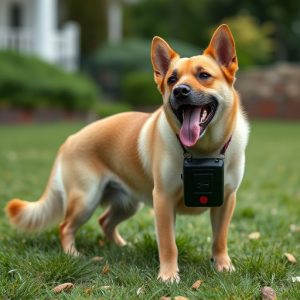Decoding the Electronic Barking Dog Alarm: Uses, Science, and Future Innovations
Electronic barking dog alarms are sophisticated security devices designed to mimic the sound of a r…….
Electronic barking dog alarms are sophisticated security devices designed to mimic the sound of a real dog's bark using advanced audio technology. They effectively deter intruders by emitting a high-pitched, realistic canine alarm that is both attention-grabbing and unsettling to potential trespassers. These alarms come with adjustable pitch and timing, ensuring they blend well with different environments and are customizable for various security needs. They feature sophisticated sensor systems that minimize false alarms by distinguishing between unauthorized activity and routine occurrences. The microelectronics within these devices process real-time data to enhance their effectiveness in home and public safety contexts. Moreover, the latest models are expected to integrate with smart home systems, allowing for remote control via mobile devices, and may incorporate AI to refine their sensitivity and accuracy. As a non-lethal intruder deterrent, electronic barking dog alarms serve as a reliable, humane, and versatile tool in enhancing security measures without the need for a live dog, thus complementing broader home security strategies.
Exploring the multifaceted role of electronic barking dog alarms, this article dissects their mechanics, applications, and future advancements. From their initial conception as deterrent systems to their evolving use in various sectors, these devices have become a cornerstone in security and behavioral modification strategies. We’ll delve into the science behind their operation, assess their effectiveness across different scenarios, and provide guidance on selecting the most appropriate model for your specific requirements. Join us as we investigate the electronic barking dog sound landscape, its impact, and where innovation is set to take it next.
Understanding the Electronic Barking Dog Sound: An Overview
The electronic barking dog sound, often generated by an electronic barking dog alarm, is a synthetic reproduction of a real canine’s audible alert. This sonic cue is designed to mimic the natural bark of a dog with high precision, ensuring it captures the nuances and characteristics of a genuine bark. The development of these alarms has been influenced by advancements in audio technology, allowing for a more realistic and startling experience when an alarm is triggered. These devices are widely used for various applications, from home security systems to public safety announcements, serving as a reliable auditory signal that can effectively grab the attention of individuals within its range.
When selecting an electronic barking dog sound alarm, it is crucial to consider the clarity and volume of the bark simulation. The most effective models produce a sound that is indistinguishable from a real dog’s bark, thereby deterring potential intruders or alerting occupants to a potential hazard. Additionally, the pitch and timing of the bark can be adjusted in many electronic barking dog alarms, providing users with the flexibility to customize the sound to their specific needs or preferences. This adaptability makes the electronic barking dog alarm a versatile tool for enhancing security and safety measures across different environments, from residential properties to commercial establishments.
The Science Behind Electronic Barking Dog Alarms: How They Work
Electronic barking dog alarms are a non-lethal means of deterring intruders, employing an auditory signal that simulates the sound a real canine would make. These devices are engineered with a sensor system designed to detect unauthorized entry or movement within a specified range. Upon activation, the alarm emits a high-pitched, abrupt barking sound that mimics a dog’s alarm call, which is perceived as aggressive and startling to potential intruders. This artificial canine alert not only startles but also confuses the intruder by creating the illusion of an actual threat, potentially deterring further action.
The science behind these alarms lies in the principles of acoustic engineering and motion detection technology. The alarm’s sound module operates on a frequency that is most likely to carry across various environments, ensuring it can be heard over considerable distances. The microelectronics within the device process the sensor data in real-time, distinguishing between the movements of an intruder and those caused by natural occurrences or pets. This advanced discrimination capability minimizes false alarms while maximizing the effectiveness of the security measure. When activated, the alarm’s sound is crafted to be as realistic as possible, utilizing a range of frequencies that closely resemble the vocalizations of a territorial dog. This realism is key to the alarm’s efficacy, as it relies on the psychological impact of the sound rather than physical force to deter intruders. The strategic placement of these electronic barking dog alarms can serve as a formidable component in a comprehensive home security system.
Applications of Electronic Barking Dog Sounds: Beyond an Alarm
Electronic barking dog sounds serve a multifaceted role beyond their traditional use as an alarm. These sounds, reminiscent of a canine’s natural warning barks, are ingeniously applied in various settings for enhanced security and behavioral conditioning. In the realm of home security, the electronic barking dog alarm is a deterrent that simulates the sound of an agitated dog without the need for an actual animal. This technology is designed to startle potential intruders, effectively mimicking the protective instinct of a guardian dog. The sudden, authoritative bark triggers a psychological response in would-be trespassers, often leading them to retreat rather than confront the perceived threat.
Beyond personal safety, these electronic alarms are also employed in commercial and public spaces to curb unwanted behaviors such as loitering or vandalism. The presence of an electronic barking dog sound system acts as a behavioral cue, signaling individuals that their actions are being monitored and could trigger a response. This proactive approach to security not only helps in deterring criminal activities but also contributes to maintaining order and safety in public venues, transportation hubs, and retail environments. The adaptability of these electronic sound systems makes them an invaluable tool in modern security strategies, complementing visual surveillance with an auditory deterrent that is both effective and humane.
Choosing the Right Electronic Barking Dog Alarm for Your Needs
When considering an electronic barking dog alarm for your property, it’s crucial to assess your specific needs and the circumstances under which the device will be used. The right alarm should serve as a deterrent against intruders, mimicking the startling sound of a real canine’s bark to effectively ward off unwanted guests. Factors such as the size of your property, the level of noise permissible in your area, and the frequency of use will influence which model best suits you. High-quality electronic barking dog alarms offer realistic sound reproduction, a variety of volume settings, and are often weatherproof for outdoor use. They may also come with additional features like motion sensors or integration with other security systems to enhance their functionality. It’s important to evaluate the decibel level of the alarm, as this will determine its effectiveness in startling an intruder. Additionally, consider the power source requirements; some models are battery-operated and boast long life spans, while others need to be plugged into a mains outlet. By carefully selecting the electronic barking dog alarm that aligns with your security needs and environmental conditions, you can ensure a formidable layer of protection for your home or business.
Innovations and Future Developments in Electronic Barking Dog Alarms
The electronic barking dog alarm has evolved significantly over recent years, with innovations focused on enhancing its realism and functionality. Current models mimic the natural canine vocalizations with high fidelity, effectively deterring intruders by emulating an actual bark without the need for a physical dog. As these devices become more sophisticated, future developments promise even greater integration with home security systems, allowing for remote activation and control via smartphones or smart home devices. This will enable users to simulate the presence of a guard dog from anywhere in the world, providing peace of mind and an additional layer of security. Moreover, advancements in artificial intelligence are likely to refine the alarm’s trigger mechanisms, ensuring it responds accurately to specific stimuli, thus minimizing false alarms. With ongoing research and development, the electronic barking dog alarm is poised to become a more integral component of home defense systems, offering a cost-effective, non-lethal deterrent that replicates the protective qualities of a real dog.


